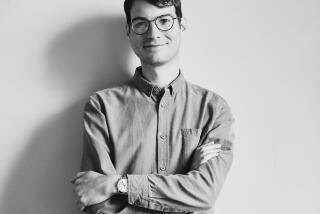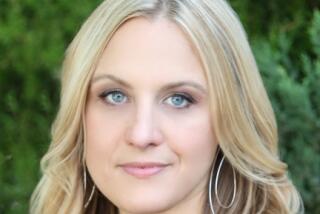Book review: ‘House of Prayer No. 2’ by Mark Richard
House of Prayer No. 2
A Writer’s Journey Home
Mark Richard
Nan A. Talese: Doubleday: 207 pp., $23.95
“No one,” Mark Richard writes in “House of Prayer No. 2: A Writer’s Journey Home,” “will lead you down a slippery path faster than your best friends.”
Yet if there’s a message to this unlikely personal history of a spiritual awakening, it’s that temptation and false starts are everywhere. You find them not just with your friends, but with your family, your body, your spirit — even, in a very real sense, with God. “You go down the long hallway to Graham Ward, where the infants are,” Richard recalls, describing one of several stays in Richmond’s Crippled Children’s Hospital (he was born with a degenerative hip condition). “You walk around and look into cribs and see a lot of God’s mistakes.”
Only a believer and a fellow sufferer would be so matter-of-fact about God’s fallibility, would see it as a fundament of faith.
“You do not offer platitudes to people in their times of need.…You also do not offer prayers in the hopes of changing things,” he argues. “You have come to believe that those types of prayers are dangerous, especially when the word ‘if’ is used. Those types of prayers are a type of negotiation, and you are beginning to believe that negotiation with God is sinful.”
“House of Prayer No. 2” is Richard’s first book of nonfiction; his other works include the bestselling novel “Fishboy” and two collections of short fiction, one of which, “The Ice at the Bottom of the World,” won a 1990 PEN/Hemingway Award. He’s taught at the University of Arizona and UC Irvine, has written for film and television and is a recipient of a Whiting Foundation Writer’s Award. In his new book, he traces his life from “special child” to man of spirit, from Virginia (where he was raised) to Los Angeles (where he lives today). Written in second person, it is less a memoir than an impressionistic self-portrait in which memory and myth conflate in places, and the borders between reality and imagination, between the natural and supernatural, grow thin.
“The problem with asking God for signs,” Richard notes, “is that He sends them. You drive along a country road late at night and see a little cross atop a little church lit with a spotlight and you say, Okay, if You are real, make that light go out, and the light goes out.”
The book is peppered with such moments, although the challenge for readers and for the author is what to believe. Nat Turner, he tells us, also asked for signs and “was given a green eclipse of the sun that was witnessed from Charleston, South Carolina, to New York City, so he and his disciples began killing as many white people in your county as they could, mostly with axes, swords, and hand tools.… Before they cut off Nat Turner’s head and spiked it on a crossroads daring anyone to touch it, Nat sat in his cell and confessed that he was a prophet, a man of God.”
For Richard, this is more than just a story, more than just a parable gone wrong. Among Turner’s 56 victims were ancestors of Richard’s grade school classmates; other classmates were descendants of the “[h]undreds of blacks … killed in the weeks afterward.” And yet, he insists, there is still a question of interpretation — of the signs and what we see in them. This is why he casts “House of Prayer No. 2” in the second person, as if to draw us into his life, as if to emphasize that all these recollections come to us not as they were but refracted through an internal lens.
Such a distance begins with Richard’s outsider status — he spent much of his childhood in body casts or on crutches. It extends through his wild days as a student and beach bum, a drinker and hell-raiser with a habit of letting people down. One night, at a bar, he pretends to testify; he is so convincing that a fellow patron asks where he preaches. “You have to tell him,” Richard writes, “you don’t preach, you’re not a preacher, you were just messing around … and he’s so disappointed in you that you go out in the parking lot and wait there for the rest of your crowd to finally come out much later.”
Even more fraught is his relationship with his family, and especially his father, from whom he ends up estranged. If, as he suggests, “a man’s relationship with God is determined by his relationship to his father,” then Richard’s long search for transcendence is also a quest for acceptance, a point he makes explicit when, during a visit to reconnect with his dying father, he is told by a doctor, “Why don’t you just make your peace and hit the dusty trail?”
This is a perfect metaphor for the journey at the book’s heart, the journey that confronts us all. In it, however, we also see the limitations of Richard’s memoir, which, paradoxically, grows less engaged the closer to God he becomes. To be fair, I suppose, that’s because “the Call,” as he refers to this movement of the spirit, can be intangible and difficult to describe—-especially in this case, where it comes on slowly, after a lifetime of back-and-forthing, rather than in one ecstatic thunderclap.
Still, Richard is an accomplished writer, so what gets in his way? It’s the balance between distance and connection, the shift from outside to inside. As long as “House of Prayer No. 2” is a story of exile, it remains elusive and nuanced. After the narrative narrows, and Richard achieves success as a writer and a sense of mission, the detachment collapses without an equivalent shift in voice.
“Freud said storytelling is unconscious desire to summon fears in order to be able to exorcise them,” he observes, in a lovely encapsulation of the writer’s art. But by the book’s end, those fears have been replaced by a more generalized sense of belonging, leaving behind that other, more volatile Richard who, “like your favorite writer, Flannery O’Connor … believe[s] the biggest threat to your soul is you.”
More to Read
Sign up for our Book Club newsletter
Get the latest news, events and more from the Los Angeles Times Book Club, and help us get L.A. reading and talking.
You may occasionally receive promotional content from the Los Angeles Times.







